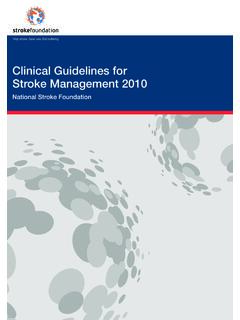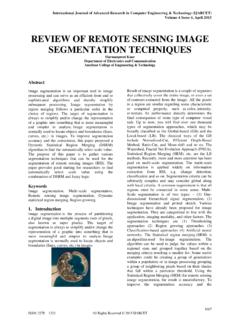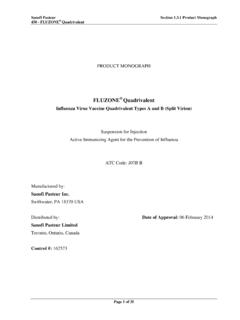Transcription of PEDro scale
1 Last amended June 21st, 1999 PEDro scale 1. eligibility criteria were specified no yes where: 2. subjects were randomly allocated to groups (in a crossover study, subjects were randomly allocated an order in which treatments were received) no yes where: 3. allocation was concealed no yes where: 4. the groups were similar at baseline regarding the most important prognostic indicators no yes where: 5. there was blinding of all subjects no yes where: 6. there was blinding of all therapists who administered the therapy no yes where: 7.
2 There was blinding of all assessors who measured at least one key outcome no yes where: 8. measures of at least one key outcome were obtained from more than 85% of the subjects initially allocated to groups no yes where: 9. all subjects for whom outcome measures were available received the treatment or control condition as allocated or, where this was not the case, data for at least one key outcome was analysed by intention to treat no yes where: 10. the results of between-group statistical comparisons are reported for at least one key outcome no yes where: 11.
3 The study provides both point measures and measures of variability for at least one key outcome no yes where: The PEDro scale is based on the Delphi list developed by Verhagen and colleagues at the Department of Epidemiology, University of Maastricht (Verhagen AP et al (1998). The Delphi list: a criteria list for quality assessment of randomised clinical trials for conducting systematic reviews developed by Delphi consensus. Journal of Clinical Epidemiology, 51(12):1235-41). The list is based on "expert consensus" not, for the most part, on empirical data.
4 Two additional items not on the Delphi list ( PEDro scale items 8 and 10) have been included in the PEDro scale . As more empirical data comes to hand it may become possible to "weight" scale items so that the PEDro score reflects the importance of individual scale items. The purpose of the PEDro scale is to help the users of the PEDro database rapidly identify which of the known or suspected randomised clinical trials (ie RCTs or CCTs) archived on the PEDro database are likely to be internally valid (criteria 2-9), and could have sufficient statistical information to make their results interpretable (criteria 10-11).
5 An additional criterion (criterion 1) that relates to the external validity (or generalisability or applicability of the trial) has been retained so that the Delphi list is complete, but this criterion will not be used to calculate the PEDro score reported on the PEDro web site. The PEDro scale should not be used as a measure of the validity of a study s conclusions. In particular, we caution users of the PEDro scale that studies which show significant treatment effects and which score highly on the PEDro scale do not necessarily provide evidence that the treatment is clinically useful.
6 Additional considerations include whether the treatment effect was big enough to be clinically worthwhile, whether the positive effects of the treatment outweigh its negative effects, and the cost-effectiveness of the treatment. The scale should not be used to compare the "quality" of trials performed in different areas of therapy, primarily because it is not possible to satisfy all scale items in some areas of physiotherapy practice. Notes on administration of the PEDro scale : All criteria Points are only awarded when a criterion is clearly satisfied. If on a literal reading of the trial report it is possible that a criterion was not satisfied, a point should not be awarded for that criterion.
7 Criterion 1 This criterion is satisfied if the report describes the source of subjects and a list of criteria used to determine who was eligible to participate in the study. Criterion 2 A study is considered to have used random allocation if the report states that allocation was random. The precise method of randomisation need not be specified. Procedures such as coin-tossing and dice-rolling should be considered random. Quasi-randomisation allocation procedures such as allocation by hospital record number or birth date, or alternation, do not satisfy this criterion.
8 Criterion 3 Concealed allocation means that the person who determined if a subject was eligible for inclusion in the trial was unaware, when this decision was made, of which group the subject would be allocated to. A point is awarded for this criteria, even if it is not stated that allocation was concealed, when the report states that allocation was by sealed opaque envelopes or that allocation involved contacting the holder of the allocation schedule who was off-site . Criterion 4 At a minimum, in studies of therapeutic interventions, the report must describe at least one measure of the severity of the condition being treated and at least one (different) key outcome measure at baseline.
9 The rater must be satisfied that the groups outcomes would not be expected to differ, on the basis of baseline differences in prognostic variables alone, by a clinically significant amount. This criterion is satisfied even if only baseline data of study completers are presented. Criteria 4, 7-11 Key outcomes are those outcomes which provide the primary measure of the effectiveness (or lack of effectiveness) of the therapy. In most studies, more than one variable is used as an outcome measure. Criterion 5-7 Blinding means the person in question (subject, therapist or assessor) did not know which group the subject had been allocated to.
10 In addition, subjects and therapists are only considered to be blind if it could be expected that they would have been unable to distinguish between the treatments applied to different groups. In trials in which key outcomes are self-reported (eg, visual analogue scale , pain diary), the assessor is considered to be blind if the subject was blind. Criterion 8 This criterion is only satisfied if the report explicitly states both the number of subjects initially allocated to groups and the number of subjects from whom key outcome measures were obtained.









